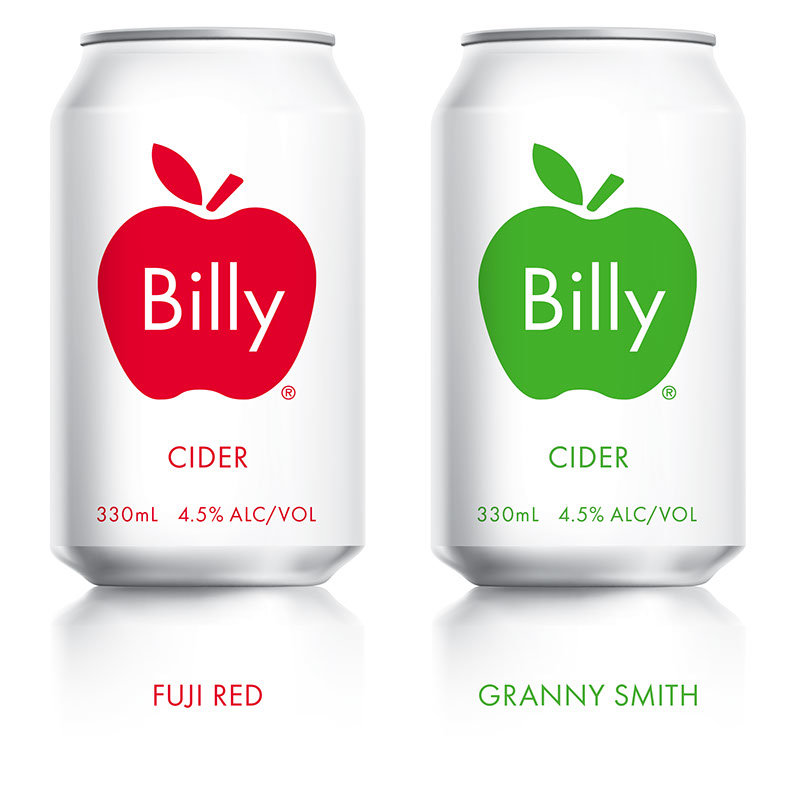
Fifty three years ago, the artist formerly known as Barrie Bates created a new brand, Billy Apple, aka himself.
The New Zealand-born artist, a contemporary of pop art names like David Hockney and Andy Warhol, wanted to establish a new relationship between the artist and everyday life, by exploring how he could be redefined as a “product” with his own distinct brand.

Billy Apple, Billy Apple®, 2012, courtesy of Starkwhite, Auckland. Photographer Hans-Georg Gaul, Berlin
Now with his 80th birthday approaching and on the eve of a major retrospective of his work at the Auckland Art Gallery, Apple has moved deeper into the commercial world, launching two Billy Apple-branded ciders, red and green.
Working with Saatchi & Saatchi’s worldwide director of design Derek Lockwood, the first batch of almost 50,000 cans of the cider is in production and due to be packed and shipped next week.

First Billy Apple cider cans hit the production line
Lockwood is expecting it will go on sale in bars, restaurants and premium retail outlets around the time of the launch of Apple’s new exhibition “The artist has to live like anyone else” on March 14.
Lockwood, who has known Billy Apple for more than 20 years, both personally and through his work with Saatchis, says he has always been interested in commercialising a Billy Apple-branded product.

Billy Apple, Motion Picture Meets the Apple (detail), 1963, Chartwell Collection, Auckland Art Gallery Toi o Tamaki
A serious attempt to grow and market a Billy Apple apple in the early 2000s failed, but Lockwood says the cider production is long-term venture.
“There’s something amazing about commercializing Billy’s stuff and blurring the line between art, branding and what we do as a commercial enterprise.”

Billy Apple, Two Minutes 33 Seconds (Red), 1962/2010, painted cast bronze, edition of 3, 132 x 356 x 152mm, collection of the artist
“The cider category is growing phenomenally, so it felt like this was commercially viable long-term,” Lockwood says.
Nielsen ScanTrack data shows supermarkets sold six million litres of cider in the year to January 2015, up from four million litres two years before. In dollar terms, that’s the equivalent of a 60% rise, to $47m.
Lockwood says the Billy Apple cider is being branded and marketed through his own company, and profits will be split. The recommended retail price is $15.99 for a four pack.
He says they chose to package the cider in a can, rather than the more usual bottle, because the shape provides “a beautiful blank canvas”.
“It’s unusual; it feels right. Bottle forms were more complex and generic. The can’s a classic basic shape.”

The history behind Billy Apple’s name and art will be important in selling the new cider, Lockwood says.
“It will have a deeper story than most brands in the market.
“The nature of Billy’s work has been around the transactional. As he says, in 1964 [with the pivotal pop art exhibition American Supermarket in New York] he took the supermarket into the art gallery. Now he’s taking the art gallery into the supermarket.
“What you have is a blend of product, art and branding.”

Billy Apple, Sold, 1981, acrylic on canvas, 2145 x 1525mm, private collection
Another unique selling point is that the cider, like all of Billy Apple’s work, is created according to the Golden Ratio (also known as the Fibonacci formula.
The ratio is found frequently in nature and is seen as determining “ideal beauty and perfection”, according to BillyAppleCider.com.
In cider terms, it means blending different four apple brands according to the Fibonacci ratio.

Lockwood said it was a steep learning curve going from design and branding for other people’s products, to making his own product.
“It’s nice to be totally dealing with the practical – I’m getting a hell of a lot closer to the reality of product launches.
“Wouldn’t it be great if something that’s beautiful and designy is loved by the consumer as well.”
Billy Apple®: The Artist Has to Live Like Everybody Else opens at Auckland Art Gallery on March 14 and runs until June 21.




